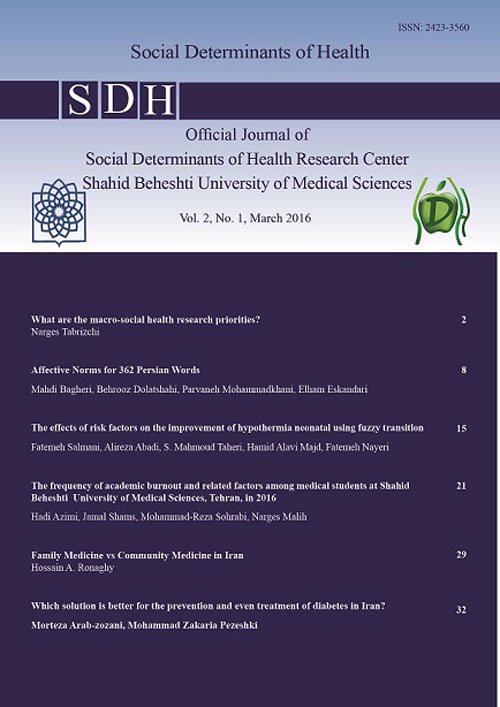فهرست مطالب

Social Determinants of Health
Volume:2 Issue: 1, 2016
- تاریخ انتشار: 1395/06/28
- تعداد عناوین: 5
-
-
Pages 8-14BackgroundDuring the past two decades, a great deal of research has been conducted on developing affective norms for words in various languages, showing that there is an urgent need to create such norms in Persian language, too. The present study intended to develop a set of 362 Persian words rated according to their emotional valence, arousal, imageability, and familiarity so as to prepare the ground for further research on emotional word processing. This was the first attempt to set affective norms for Persian words in the realm of emotion.MethodsPrior to the study, a multitude of words were selected from Persian dictionary and academic books in Persian literature. Secondly, three independent proficient experts in the Persian literature were asked to extract the suitable words from the list and to choose the best (defined as grammatically correct and most often used). The database normalization process was based on the ratings by a total of 88 participants using a 9-point Likert scale. Each participant evaluated about 120 words on four different scales.ResultsThere were significant relationships between affective dimensions and some psycholinguistic variables. Also, further analyses were carried out to investigate the possible relationship between different features of valences (positive, negative, and neutral) and other variables included in the dataset.ConclusionThese affective norms for Persian words create a useful and valid dataset which will provide researchers with applying standard verbal materials as well as materials applied in other languages, e.g. English, German, French, Spanish, Portuguese, Dutch, etc.Keywords: Affective ratings, Arousal, Imageability, Valence
-
Pages 15-20BackgroundNeonatal hypothermia is a major risk factor for mortality after delivery. The present study aims to identify the risk factors associated with transition in hypothermia state with new definition of hypothermia states.MethodsA total of 479 neonates hospitalized in Neonatal Intensive Care Unit of Valiasr Hospital, Tehran, Iran, in 2005, participated in the study. The rectal temperature of neonates were measured immediately after delivery and every 30 min afterwards, until their temperature became normal.ResultsThe mean weight of neonatal was 2580±882.9 grams and the mean of delivery room temperature was 29.2±1.45 °C. Most of the neonates had mild hypothermia. There were significant associations between the weight of neonate, Cardiopulmonary Resuscitation, and Apgar scores and hypothermia state (PConclusionFindings of the current study indicated that a major risk factor for hypothermia was low weight of the neonates.Keywords: Neonatal, Hypothermia, Temperature, Fuzzy transition model
-
Pages 21-28BackgroundAcademic burnout is the state of negative emotions and low motivation in ones education. Understanding the status of academic burnout is the primary step to make proper decisions. The present study, therefore, was conducted to investigate comparative degrees of academic burnout among medical students in their first five semesters of medical education at Shahid Beheshti University of Medical Sciences, Tehran, Iran.MethodsIn the present cross-sectional study, a total of 525 medical students at the School of Medicine filled out the Persian version of Maslach Burnout Inventory Student Survey from January 15 to February 5, 2016. Chi square, Mantel-Haenszel, and KruskalWallis tests were run in SPSS for data analysis. P-valueResultsBased on the collected data, it was shown that 49.2% of the participants were male and 50.8% were female. Only 8 (1.5%) participants were married. No statistically significant difference was observed between the variables investigated and academic burnout (P>0.05). It was also observed that only four (0.8%) medical students (all new-comers) were in low academic burnout group and 521 (99.2%) were categorized in medium academic burnout group. Finally, it was found that academic burnout of the students increase as their educational level advance, making the first-semester students having the lowest and fifth-semester students the highest academic burnout indices (PConclusionIt is concluded that, from among the variables studied, only students educational level made a difference in medical students academic burnout.Keywords: Academic efficacy, Burnout, Cynicism, Exhaustion, Medical Students
-
Pages 29-31

